Sakuma Shōzan
| Sakuma Shōzan | |
|---|---|
|
Sakuma Shōzan | |
| Born |
March 22, 1811 Nagano Prefecture, Japan |
| Died |
August 12, 1864 (aged 53) Kyoto, Japan |
Sakuma Shōzan (佐久間 象山, March 22, 1811 – August 12, 1864) sometimes called Sakuma Zōzan, was a Japanese politician and scholar of the Edo era.
Biography
Shozan was the son of a samurai, and a native of Shinshū (信州) in today's Nagano Prefecture. At the age of 23, he went to Edo and for 10 years studied Chinese learning (漢学).
He then started to study Western sciences ("rangaku") at the age of 33, with the help of the rangaku scholar Kurokawa Ryōan (黒川良安). In 1844, he obtained the "Huishoudelyk Woordboek", a Dutch translation of Nöel Chomel's encyclopedia, from which Sakuma learned how to make glass, and then magnets, thermometers, cameras and telescopes. The encyclopedia was later translated into Japanese by Utagawa Genshin (宇田川玄真) under the title 『厚生新編』.
In 1849, he learned about electricity, through the book of the Dutch scientist Van den Bergh, and created Japan's first telegraph, five years before the gift of such a telegraph by Commodore Perry in 1854. He also invented electric machines derived from the Elekiter.
From 1842, following an analysis of the defeat of China against Great Britain in the First Opium War and the spread of Western influence in Asia, Sakuma actively proposed the introduction of Western military methods to the Bakufu and the establishment of maritime defense, through his book "Eight policies for the defense of the sea" (海防八策). After the Bakufu ordered Japanese translations of the Military History of the Qing dynasty (聖武記, Shèngwu Ji) and the Illustrated Treatise on the Maritime Kingdoms written by Chinese scholar Wei Yuan (1794–1857), Sakuma was struck by the similarities in their ideas in defending against the west.[1] His writing brought some fame, and he became the teacher of several future leaders of modernization (Yoshida Shōin, Katsu Kaishū, Sakamoto Ryōma).
In 1853, when Yoshida Shōin was convicted for attempting to stow away on one of Perry's ships, Sakuma was also sentenced by association to house arrest (蟄居), which he endured for 9 years. During the arrest, he continued to study Western sciences, and developed various electric machines based on the elekiter and the Daniell battery, Japan's first seismic sensor, as well as improvements to guns. After his release, Sakuma Shozan continued to advocate opening Japanese ports to foreign traders, as well as reinforcing the Bakufu through collaboration with the Imperial administration (Kōbu gattai).
Shōzan was murdered by an assassin, a hitokiri named Kawakami Gensai, who killed Shozan with a single strike in broad daylight.
Sakuma Shozan coined the phrase "Eastern ethics, Western technical learning" (tōyō dōtoku, seiyō gakugei, 東洋道徳西洋学芸) which was later further abbreviated as "Japanese spirit, Western technique" (wakon yōsai, 和魂洋才). This latter slogan is still in use as a description of the way that Japan ought to handle modernization.[2]
Shozan's son Miura Keinosuke 三浦啓之助 was a member of the Shinsengumi.[3]
Notes
External links
| Wikimedia Commons has media related to Sakuma Shōzan. |
This article incorporates text from OpenHistory.
